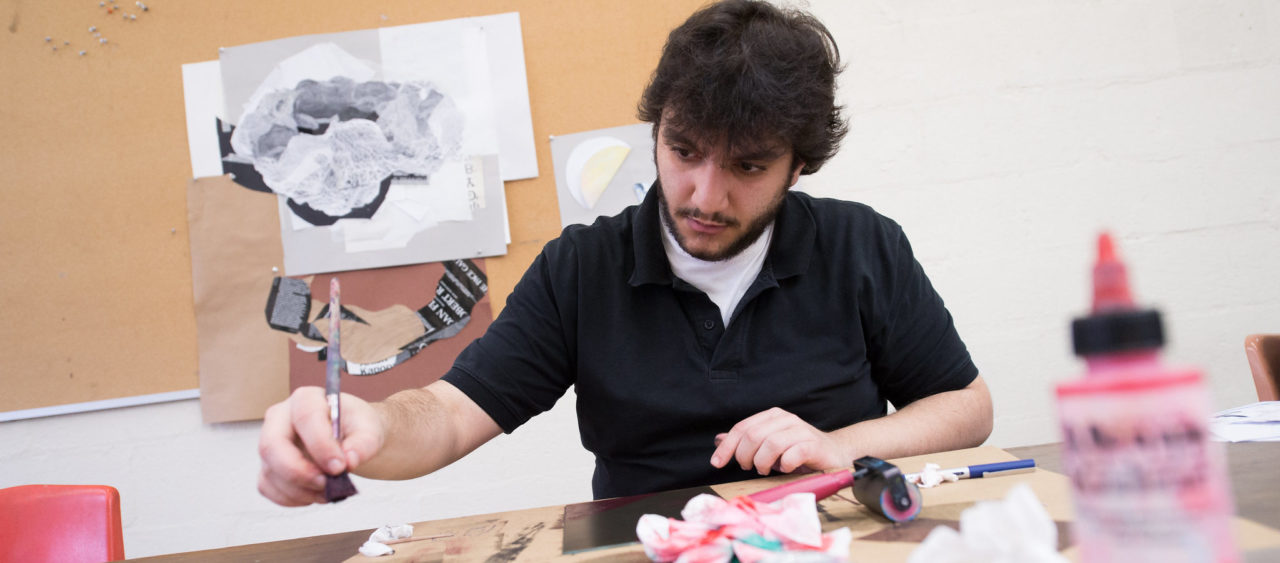Studio Arts Minor

The 15-credit minor in studio arts will prepare students in the fundamentals of two-dimensional and three-dimensional visual language, allowing them to express themselves in a range of methods and materials.
These courses instill in students the conceptual foundations for understanding the creative process as well as the technical skills to implement their ideas. Student art exhibitions and faculty-led trips to museums and galleries enrich the learning experience.
The minor is offered by the School of the Arts, Maxwell Becton College of Arts and Sciences, at the Florham Campus, Madison, New Jersey.
Requirements
Required Courses (12 credits)
- ART 1201 Drawing I
- ART 1225 Painting I (or ART 1231 2-Dimensional Design I)
- ART 1235 Sculpture I (or ART 2233 3-Dimensional Design)
- ART 1315 Ceramics I
Select any one of the following (3 credits)
- ART 3452 Watercolor Painting
- ART1250 Art of the Graphic Novel
- ART1260 Ceramic Character Sculpture
- ART 2061 Animal Sculpture
- ART2316 Ceramics II
- ART2326 Painting II
- ART3302 Life Drawing
- ART3337 Life Sculpture
These classes are offered on a varied rotational schedule and are not offered every semester. Adding these two courses as options will allow greater flexibility and choices for students wishing to complete the Studio Arts Minor.
For Information
Douglas Cochrane, Fine Arts Program Director, School of the Arts, Maxwell Becton College of Arts and Sciences
Professor of Art, douglas_cochrane@fdu.edu
973-443-8640
Judith Moonelis, Fine Arts Program Director, School of the Arts, Maxwell Becton College of Arts and Sciences
Professor of Fine Arts and Studio Art, judy_moonelis@fdu.edu
973-443-8643
Course Descriptions
-
ART1201 An introduction to, and an exploration of, a selected variety of drawing materials and tech- niques. Emphasis will be placed on the comprehen- sion of the creative possibilities of pencils, charcoal and conte crayon. The course will explore the drawn line as the description of contour, light, darkness and space,as well as the tech- niques of gesture drawing, shading, texture and heightened drawing on stained paper and other drawing surfaces.
-
ART1225 An introductory course in painting, helping the student develop an ability to translate the three- dimensional reality of the outside world into a two-dimensional reality of the painting, i.e., study of a prearranged still life composed on objects to develop techniques suitable to their expression (collage, oil and tempera media).
-
ART1231 Basic elements of visual language in their appli- cation to selected problems. The study is based on formal and ideological analysis of a given object and translation of the resulting material into a two-dimensional visual system of communication. The following are examples of this visual vocabu- lary that are studied and applied to concrete projects: dynamic and static figure-ground relationships, rhythm, scale, color theory and contrasts, rotating patterns, elementary poster design. All criticism and instruction are on an individual basis.
-
ART1235 The student will be introduced to contemporary concepts of sculpture by way of traditional and contemporary materials. Drawing upon his or her own experience, pesonality and background as pri- mary resources, as well as historical considera- tions, the student will create sculpture.
-
ART1250 Students will learn to draw Graphic Novel pages. Instruction includes all stages of Fine art production ? from concept sketch to finished page (including lettering.) Students are encouraged to take Drawing I before enrolling, though it is not required.
-
ART1260 ?Ceramic Character Sculpture? will allow students to create sculptures in clay of their own original characters as models for animation, graphic novels or other personal projects. Students will learn ceramic building techniques for constructing three-dimensional figures. The class will examine the important role clay models play in development of characters. This will be explored in a range of computer based animated films (such as ?Up?/ Pixar; ?Shrek?/DreamWorks).
-
ART1315 The art of clay and glazes. Involves the student in the making of sculptural forms, vessels or functional objects. Techniques used are clay, pinching, slab and coil building, throwing on the wheel and glazing.
-
ART2061 ?Animal Sculpture? will allow students to create 3D sculptured representations of animal forms. Basic introduction to comparative animal anatomy will be explored along with direct observation from live animals. The symbolic and expressive use of animal imagery in visual art across cultures and throughout history, including contemporary art and animation, will be looked at. Course will include varied approaches to building 3D forms in clay and mixed media (ex- plaster, wire) from masks to small sculptures. Students will have the opportunity to make portraits of selected animals such as personal pets or inventions. Class trips will include Museum of Natural History, a zoo and the Metropolitan Museum of Art.
-
ART2233 A basic course that introduces the student to the ideas and language of three-dimensional design. Because of the wide range of the course, students who may be interested in sculpture, jewelry design, interior and architectural design, as well as stage design, computer animation and 3-D model- ing, can benefit from this course.
-
ART2316 A further investigation of technical and artistic considerations explored in ART 1315 Ceramics I.
-
ART2326 A continuation of ART 1225 Painting I. Special emphasis on the student's continued aesthetic, creative and technical development in painting. Four studio hours per week.
-
ART3302 A course designed to develop the capacity of visual observation of the human figure and a second base for visual development in many areas. Expression of approach: gesture drawing, movement expressed by few lines, expressive ways of trans- lating the figure.
-
ART3337 Practice in clay and plaster from live models.
-
ART3452 Watercolor painting is a beginning course in which students are introduced to simple exercises, unique tools and special techniques that help to develop competence in this beautiful medium. By mid-semester, students will be working on painting projects of their choosing. Students will supply their own materials from Instructor's list, i.e., brushes, paper and paint.